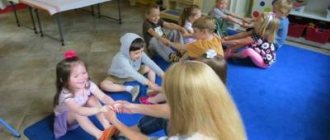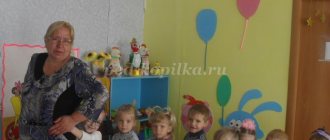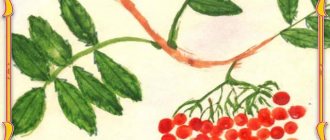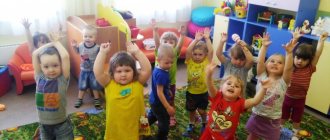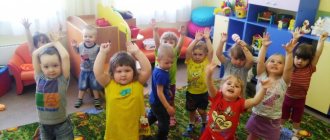Abstract of GCD for physical education in the 2nd junior group of kindergarten
Summary of an open plot GCD using non-standard physical education equipment for physical education in the II junior group
Topic: “In search of Kolobok”
Author: Natalya Anatolyevna Kichigina, teacher of MADOU No. 18 “Kindergarten “Ladushki”, Gai, Orenburg region. Description. This open educational activity was conducted by me as a final lesson on the topic of self-education “Use of non-standard physical education equipment in a preschool educational institution” and as part of the certification work for the highest qualification category. Aids: — Visual: sports equipment: massage track, “stumps” — 5 pieces; pictures: hare, wolf, bear, fox; hut; toys: Kolobok, Grandmother; samovar; dish with treats for children. — Verbal: riddles; wellness massage “Good morning”. — Musical: musical game “The Fox and the Hares”; — ICT equipment: music center. Goal: harmonious physical development of children. Objectives: Educational objectives: - increase the motor activity of children; — teach children to correlate movements with text; — promote the formation of coordination of movements; Developmental tasks: - develop the physical qualities of children; - develop in children the skills of expressive and emotional transmission of playful and fairy-tale images; — improve the ability to guess riddles based on the plot of educational activities. Educational objectives: - cultivate a sense of collectivism; - promote the manifestation of positive emotions; - cultivate desire and interest in physical education and sports. Health objectives: - prevention of flat feet using different types of walking; — formation of correct breathing when performing breathing exercises; — influence biologically active points using different types of healing massage. Children enter the hall one after another. The teacher invites the children to greet each other and guests and have a “Good morning” wellness massage. Wellness massage “Good morning”
Good morning (Spread your arms to the sides)
Smile quickly And today the whole day will be more fun!
(Clap their hands)
We will stroke our forehead, nose and cheeks
(Do exercises according to the text)
We will be beautiful, like flowers in the garden.
(Gradually raise their hands up, performing “flashlights”)
Let’s rub our palms Stronger, stronger,
(Perform movements according to the text)
And now let’s clap Bolder, bolder.
(Clap their hands)
Now we'll rub our ears And save our health
(Rub our ears)
Let's smile again Let's all be healthy!
(Raise their hands up) Educator: - Guys, I suggest you go to a fairy tale. You are ready? (Children's answers)
We will walk along the path and find a good fairy tale. The children stood up one after another, everyone walked merrily. (Walking one after another around the hall)
Let's go in a half-squat, maybe we'll find a fungus
(Walking in a half-squat)
Let's stand together on our tiptoes, And let's stretch a little.
(Walking on toes)
We will walk again, It’s good for us to walk.
(Regular walking)
But it's time to hurry up, It's time to start the fairy tale.
(Easy jogging)
Again we walk together, Raise our hands to the top
(Walking one after another, breathing exercises)
Let’s all approach the house Let’s begin a good fairy tale.
(They approach the house) Educator: - So, we found ourselves in a fairy tale. Let’s try to guess what kind of fairy tale this is: Round side, ruddy side Rolled…. (Kolobok) Educator: -Well done, guys! Look, a grandmother is sitting near the hut and crying bitterly. She lost Kolobok. Guys, let's help Grandma find and return Kolobok. Let's hit the road! Children go out into the clearing and meet a fairy-tale character - a hare. Educator: -Oh, guys, someone is hiding here. Let's try to guess: Long ear, ball of fluff, Jumps deftly, loves carrots. (Bunny) - That's right, guys, it's a bunny. Let's teach the bunny to do exercises in order to become strong and dexterous. Children perform the musical and rhythmic composition “Fun Exercise”
Educator: -Well done, guys! We have now become strong and dexterous and can continue to go in search of Kolobok. Children meet a fairy tale character - a wolf. Educator: -Guys, let's go on in search of Kolobok. Is someone hiding here? Let's guess: Who walks around angry and hungry in the cold winter. (Wolf) - That's right - it's a wolf. To find Kolobok, the wolf invites us to follow in his footsteps. Children follow each other along a massage path with footprints.
Educator: -Well done, everyone coped with the wolf’s task. We continue our search for Kolobok. Guys, look, someone is meeting us here. Let's get a look! Clubfoot and big, He sleeps in a den in winter. He loves pine cones, he loves honey, Well, who can name it? (Bear) - Bear has prepared a task for us. He invites us to go through the stumps. Children step over the “stumps” with their legs raised high.
-What a great fellow you are, you overcame almost all the obstacles.
Oh, someone's hiding here. Let's see who it is? (the teacher takes out the fox). Yes, it's a fox! -Guys, our fox is somewhat depressed. Let's make the fox laugh and play with her, maybe then she will give us Kolobok. But first we need to turn into bunnies. One, two, turn around and turn into a rabbit! Children turn into bunnies and an active musical game “The Fox and the Hares” and breathing exercises are performed.
- The fox gives us Kolobok for our fun and interesting game.
Thank you, fox. Children "Bunnies" turn into guys. They take Kolobok and return him to Grandma. Educator: - Thank you guys for helping the little bun return home. Educator: -Guys, let's remember our journey. To sum up the GCD, the children answer the questions: What fairy tale did you visit? Who did you meet along the way? What did you do with the bunny? What did they do with the wolf? What did you do with the bear? What about the fox? Educator: - Oh, guys, while we were talking, grandma baked us a treat. (treats are distributed to the children) To the music, the children leave the hall.
We recommend watching:
Summary of OOD on speech development in the second junior group of a preschool educational institution Summary of a comprehensive visual lesson in the second junior group on the topic: Spring
Similar articles:
Physical education lesson in the 2nd junior group. Abstract
Summary of GCD in the 2nd junior group on the topic: Autumn
Junior group. Early childhood, nursery. Children 1-4 years old
Physical education lesson in an early age group “Secrets from an envelope”
Goal: physical development and strengthening of the body of a young child. Objectives: Educational: - Practice rolling the ball to each other in a straight direction - Improve the ability to crawl on a gymnastic bench, - Accustom them to perform tasks independently. Developmental: develop...
Training sessions “Physical education” in the second group of early age DECEMBER Card No. 1 Lesson 1 Tasks . Practice walking up and down on an inclined board, learn to throw and catch a ball, be attentive, try to do exercises together with other children. Benefits. Short colored ribbons according to the number of children, 1-2 inclined boards, a ball....
Methodology for conducting physical education classes in the 2nd junior group
Methods of physical education in the younger group
Prepared by physical education instructor T.Yu. Feofanova.
Protecting and promoting health, improving the functions of a child’s body and his full physical development are an integral part of pedagogical work in preschool institutions.
From an early age, much attention is paid to the formation of correct posture, motor skills, coordination of movements, spatial orientation, development of physical qualities, as well as instilling cultural and hygienic skills and interest in physical exercise, which contributes to the formation of moral qualities, strong-willed personality traits, and maintaining a healthy lifestyle .
Methodically
Properly organized physical education classes are designed to satisfy children’s natural need for movement and contribute to their timely acquisition of motor skills and abilities.
Physical education classes in the second junior group
are carried out 3 times a week for 15 minutes.
(2 in the hall, one on the street)
;
They are built according to the usual structural scheme, that is, they consist of an introductory (2-3 min., main (10 min.)
and final
(2-3 min.)
parts, each of which has its own tasks.
Introductory part.
The exercises in this part of the lesson mobilize children’s attention and prepare the body for the upcoming physical activity.
These are exercises in walking and running, formations and changes, various tasks with objects (flags, rattles, cubes)
are performed as directed by the teacher, sometimes with musical accompaniment. For example, children walk in a column one at a time with cubes in their hands, the teacher suggests stopping and knocking the cubes in front of them, above their heads, on the floor, etc. The actions are similar with other objects: rattle rattles, wave flags.
Walking and running exercises must be alternated: first, children walk (incomplete circle, and then run (full circle)
; tasks are repeated 2 times.
Formations and rearrangements develop children's spatial orientation and help them comprehend their motor actions and those performed by their peers.
In the first lessons there is no organized structure yet; at first, children only practice joint actions in small groups or the whole group in a playful way
, for example, “Let’s go visit the doll
(bear)
.”
After several lessons, the simplest formations are used - in a line, in a column, one at a time. The teacher himself arranges the children in a column one at a time in small groups in the form of a game like “Train”
,
“Tram”
.
It should be remembered that kids are still not coping well with the task: they run ahead, lag behind each other, and cannot remember their place in the column.
To teach walking and running in a column one at a time, the teacher can use a rope or cord (children are taken with one hand)
. But this technique does not always pay off, since the children’s movements become unnatural. When they move freely, they learn the task more easily.
Formation in a circle is carried out according to landmarks (objects, pre-arranged cubes, rattles, flags, balls, etc. In pairs, children are first lined up with the help of the teacher: he invites the children to stand in a line, then in a column one at a time, each child standing second in a column, puts him next to the first and invites him to join hands. Walking in pairs is carried out at an average pace (running in pairs is still difficult for children)
.
Main part (10-15 min)
includes: general developmental gymnastic exercises with and without various objects, basic movements (balance exercises, climbing, jumping, throwing, outdoor play.
General developmental exercises. When performing them, children stand in a circle or scattered around objects
(cubes, rattles, skittles)
.
It is advisable to introduce formation in a circle at the beginning of the year, when children have not yet learned to move quickly and in an organized manner. In the future, it is advisable to use various formations: in two ranks (two semicircles, in the form of the letter P, scattered around objects
, in a checkerboard pattern around chairs, etc.
The teacher makes sure that the children take the correct starting position, as this determines the overall load on the body and on individual muscle groups
.
The starting positions are very diverse: standing, sitting, kneeling, lying on your back and stomach. The transition from one starting position to another must be consistent. So, if children need to be transferred from a standing position to a lying position, they are asked to first put their legs closer to each other and, gradually lowering, sit down, and only then lie down (if the children are well prepared, then you can offer to cross their legs and then sit down). Transitioning from a standing to a kneeling position requires children to first squat and then lower smoothly (without hitting their knees)
.
When conducting general developmental exercises in a standing position for children, as a rule, two positions of the legs are used: at the width of the feet and at the width of the shoulders.
The teacher performs tilts and turns with children only 1-2 times. Then the kids continue the exercise independently as directed by the teacher.
The teacher demonstrates almost all the exercises himself. But some of them can be shown by a child. This exercise has been learned in advance with him. After demonstration and explanation, children perform jumps independently. Musical accompaniment helps to better assimilate the rhythm of jumping. In addition, you can use a tambourine. To the beat of the tambourine, the teacher pronounces the words “higher, higher”
or
“easier, lighter
.
For one week of every month, it is advisable to carry out general developmental exercises without objects.
. In other classes, a variety of aids are used. This makes the exercises more interesting and allows you to vary the same movements.
When selecting items
It is necessary to take into account the principle of economical organization of classes. So, if the lesson includes rolling or throwing balls, then general developmental exercises should be done with balls.
Main types of movements. When drawing up a long-term lesson plan, the teacher clearly outlines exercises for learning, repetition and consolidation. More time is allocated for completing training exercises; repetition of familiar material does not require detailed explanation, but only requires some clarification or partial demonstration.
In the second junior group
Usually two types of basic movements are planned for one lesson. The quality of exercises cannot be reduced by increasing the set of basic movements.
Proper organization of classes requires a thoughtful arrangement of aids. Therefore, in the lesson plan or outline, it is advisable to provide a diagram of the placement of aids and the location of the children and the teacher.
The condition that ensures children master motor skills is the selection of basic movements for each lesson, taking into account their physiological compatibility and gradual complication. This is achieved by repeating each session twice during the week (sometimes with minor changes)
and the correct selection of the second main movement, which in this case acts as a means of changing
(decreasing or increasing)
physical activity, as a means of revitalizing the motor experience of children, preparing them to perform a new task. For example, if in the first week of each month jumping is planned as the second movement, then in the future, when jumping is planned as one of the first main movements, this will help children to realize their potential to the fullest.
Thus, the system for planning basic movements can be presented in the following form: in the first week of each month, balance is taught and exercises in jumping, in the second, jumping is taught and throwing is practiced, in the third, throwing is taught and climbing is practiced, and finally, in the fourth — teach lasagna and practice balance.
Outdoor play is the culmination of physical and emotional stress on a child’s body.
III.
Final part (2-3 min) .
After active play, children must be brought into a calm state and only after that can they move on to other types of activities. As a rule, the final part of the lesson includes simple exercises, quiet games, and round dances.
Summary of a classic physical education lesson in the younger group
Summary of a classic physical education lesson in the younger group.
Goal: formation of motor skills, skills and development of physical qualities.
Tasks:
1. Learn to climb an inclined ladder, practice walking and running in a column one at a time.
2. Develop a sense of balance and coordination of movements, fine motor skills, and attention.
3. Foster organization and a friendly attitude towards each other.
| Contents of the exercise | Dosage | Temperature | Breath | Organizational and methodological instructions |
| I. INTRODUCTORY PART 1. Formation in a column | 3 min. 20-30 sec. | Wed* | Etc.* | We lined up like a train one after another. |
| 2. Walking | 40 sec. | Wed. | Etc. | The locomotive sets off, let's walk, raise our legs up, and straighten our back. |
| 3. Walking on your toes | 15 sec. | Wed. | Etc. | Show how tall you are - hands up. |
| 4. Easy running | 30 sec. | Wed. | Etc. | We run without bumping into each other. |
| 5. Walking with your knees high | 30 sec. | Wed. | Etc. | We walk like yoke horses, hands on our belts. |
| 6. Running | 40 sec. | Wed. | Etc. | Running and stopping at a signal to stand up. |
| 7. Walking in a circle | 45 sec. | Wed. | Etc. | The teacher catches up with the last child. If the circle is bad, then we play “Bubble”. |
| II. MAIN PART A) outdoor switchgear 1. “Umbrella” i.p.: feet hip-width apart, arms down. Raise your arms from side to side up and lower. | 10 min. 5 times | Wed. | Etc. | Place your feet in a narrow path, arms straight, sides up, umbrella open. |
| 2. “The tree” swings” IP: kneeling, hands on the belt. Lean to the right i.p., lean left i.p. | 6 times | Wed. | Etc. | Bend lower, keeping your knees on the floor |
| 3. “Sunbathing” i.p.: lying on your stomach, hands under your chin. Alternate flexion and extension of the legs. | 8 times | Wed. | Etc. | We press the leg closer to the butt. |
| 4. “Mushrooms” i.p.: feet hip-width apart, hands behind the back. Sit down and touch your toes with your toes. Stand in IP | 5 times | Wed. | Etc. | Let's place our legs in a narrow path, the back is straight, the head looks forward. |
| 5. “Balls” i.p.: legs together, hands on the belt. Jumping with a turn around yourself, alternating with walking. | 2*8 times | Wed. | Etc. | We jump easily, like balls. |
| B) ATS 1. Climbing on an inclined ladder | 2-3 times | Wed. | Etc. | Grab the rail correctly with your hands (thumb on the bottom, the rest on top), climb without missing the bars. The exercise is performed in a stream. |
| 2. Walking on the plank, hands on the belt. | 2 times | Wed. | Etc. | Keep your head and back straight. |
| B) P/n* “Find your color” (running) | 3 times | Wed. | Etc. | I divide the children into 3 groups. Rules: run to your color, what color is your flag. Don't bump into each other, don't interfere with each other. |
| III. FINAL PART 1. Low mobility game “Who is screaming”. | 3 min. 1.5 min. | Wed. | Etc. | Rules: Children pronounce the sounds of the animal that the teacher names (geese - ha-ha-ga). |
| 2. Analysis, evaluation. | 20 sec. | “What game did we play today?” Praise for performing the movements. | ||
| 3. Exit from the hall | 10 sec. | Let's go beautifully |
Average* - average
Ex.* - arbitrary
P/i* - outdoor game
Summary of the GCD “It’s good to be healthy!” for children of the second younger group
Author:
Bortsova Olga Gennadievna,
teacher
MADOOU ds No. 169 of the city of Tyumen
Goals : Development of children's cognitive interests, expansion of experience of orientation in the environment, development of general motor skills, coordination of movements, development of curiosity and cognitive motivation. Development of perception, attention, memory, observation, ability to analyze, compare features of objects, and make simple generalizations. Cultivate the desire to lead a healthy lifestyle.
Preliminary work : Examination of the album “Bad and Healthy Food”, reading fiction: “Moidodyr”, “Fedorino’s Grief” by K.I. Chukovsky, viewing the poster “Daily Routine”, viewing the cartoon “Queen Toothbrush”, looking at pictures with winter views sports
Vocabulary work: vitamins, health, hardening, hygiene.
Progress of the lesson
Educator: Hello children. This morning I met our familiar doll Tanya on the way to kindergarten. But something is wrong with her today. She looks kind of sad, has a scarf wrapped around her neck, coughs and cries. What do you think happened to her?
Children: She got sick.
Educator: Indeed, Tanya has a cold, she is unwell. Guys, do you know what health is? Children's answers.
Health is when you are cheerful, cheerful and everything works out for you. Everyone needs health - children, adults, and even animals. What should you do to be healthy? You need to want and be able to take care of your health. If you don't take care of your health, you can lose it. You want to learn how to maintain your health and get sick as little as possible.
Children: yes.
Educator: Then I propose to go on a trip to the land of Health.
We need to walk along the magic path of health (a path of massage mats is laid out)
Vitaminnaya Street.
Educator: Guys, here we are on the street of Proper Nutrition.
Tanya, the guys and I will tell you how to eat to be healthy.
Guys, look at the food I have on the table, choose those that are good for our body.
(I clarify the children’s answers.)
Educator: Vitamin A – carrots. Important for vision and growth.
Vitamin B - milk. Important for the heart.
Vitamin C – onion, protects against colds.
Guys, there is candy left on the table, is it unhealthy or healthy food. Why?
To be healthy, you need proper nutrition, you need to know which foods you can eat and which are harmful to your health.
Let's continue our journey and go to another street, which is called Fizkulturnaya.
You need to make friends with sports.
To all those who are not yet friends with him.
He will help you all cheer up.
It is very necessary for health.
Children: yes, we do morning exercises, play outdoor games, go to physical education classes.
Educator: We also arrange physical exercises. just a minute, let's show you which ones.
E. Zheleznova “Warm-up” to music.
Educator: The next street that we will go to is Purity . Guys, to be healthy, you need not only to eat vitamins and play sports, you also need to know and follow the rules of personal hygiene.
– What hygiene rules do you guys follow at home and in kindergarten? (We wash our faces in the mornings and evenings, brush our teeth, etc.)
– And the most important rule is to wash your hands with soap. Why should this be done?
Children: To be clean, to look good, to have a pleasant and healthy skin, to be hardened, to wash away germs.
There are different types of soap. (There are different types of soap on the table.) Look at liquid soap, handmade soap, baby soap, adult soap, laundry soap. That's how many varieties of soap there are.
Let's play the game "Washbasin"
- We soap our hands. We soap our hands.
- One two Three. One two Three. Let's clap our hands.
- And above the hands, like clouds. Hands up.
- Bubbles, bubbles. Jumping on two
– legs, hands on the belt.
-Educator: our journey to the land of Health has ended. Now you and our friend Tanya know that in order to be healthy you need to eat healthy food, exercise, and wash your hands with soap more often.
Be healthy!
Bibliography
- website muzofon.com
- https://nsportal.ru/detskiy-sad/zdorovyy-obraz-zhizni/2013/11/28/moe-zdorove-moe-bogatstvo
- https://best4school.ucoz.ru/news/konspekt_vneklassnogo_zanjatija_po_matematike_2_klass/2014-07-15-214
- Lazarev, M.L. Hello!: Program for the formation of the health of preschool children. - M.: Academy of Health, 1997. - 376 p.
- Kovalko V.I. ABC of physical education lessons for preschoolers. - “Wako”, Moscow 2005.
We invite teachers of preschool education in the Tyumen region, Yamal-Nenets Autonomous Okrug and Khanty-Mansi Autonomous Okrug-Yugra to publish their teaching materials: - Pedagogical experience, original programs, teaching aids, presentations for classes, electronic games; — Personally developed notes and scenarios of educational activities, projects, master classes (including videos), forms of work with families and teachers.
Why is it profitable to publish with us?
1. “Kindergartens of the Tyumen Region” is an officially registered specialized media outlet at the federal level. 2. The activities of the editorial office are supported by the Department of Education and Science of the Tyumen Region 3. We issue a “Certificate of Publication” in the media. 4. The document has a unique number, is entered in the register, has the original seal of the editorial office of the online publication and signature. 5. “Certificate of publication” in the media is sent to the author in both paper and electronic versions.
Details >>>
Sample “Certificate of publication of author’s methodological material in the media.”pdf
Share
